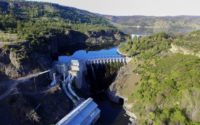Panama Canal Owner and Contractors Agree to Final Cost, Schedule Terms
Photo courtesy ACP
The two-month standoff over costs that threatened to derail an ambitious $5.2-billion expansion to the Panama Canal ended Feb. 27, when the owner and contractor building the locks portion of the project agreed to a financing plan to complete work on schedule.
The specific points of the agreement between Panama Canal Authority and contractor consortium Grupo Unidos Por el Canal (GUPC) are being drawn up into a formal document expected to be signed before March 7.
The agreement requires GUPC to complete work on the new locks by December 2015, which will allow the third lane to open for commercial traffic in the first quarter of 2016. The authority initially planned to open the expanded canal in October of this year, and the delay will mean $300 million in lost revenue, officials said.
"The Third Set of Locks will be completed within the terms of the contract, as requested from the very first day," said Panama Canal Administrator Jorge Quijano.
“The GUPC looks forward to a prompt conclusion of the agreement and funding and implementation for the efficient completion of the Third Set of Locks,” the contractor said in a statement.
GUPC, composed of Spain’s Sacyr Vallehermoso S.A., Italy’s Impregilo S.p.A., the Netherlands' Jan De Nul n.v. and Constructora Urbana, S.A. of Panama, won the design-build contract for the locks work in July 2009.
Agreement Terms
The agreement requires the owner and GUPC to each provide $100 million to “jump start” the locks work that is still recovering from the contractor’s several-week work stoppage. Work should be back at full production by the end of March, officials said.
Additionally, project insurer Zurich North America has agreed to place funds from a $400-million performance bond into a supervised escrow account that the contractor can draw on to pay subcontractors and obtain supplies.
The primary financial concession that the contractors obtained in the agreement was in the form of relief from repaying $784 million in lines of credit.
Last year, the contractor was granted a one-year moratorium on repayments that was due to expire next month. That moratorium will now be extended to 2015 and even further if certain conditions are met by the contractor.
If 12 remaining canal gates are delivered from their European manufacturer by the end of this year, repayments will be pushed back to 2016, and if the contractor can complete the locks work by December 2015, repayments won’t be required until 2018.
That arrangement provides help to the financially-plagued members of the consortium.
On Feb. 28, lead company in the consortium, Sacyr, presented its 2013 financial statement to Spanish financial regulators. The Spanish company, which has a 48% stake in GUPC, reported losses of almost $1.38 billion in the past two years.
According to the filing, $175 million in Sacyr’s writedowns were associated with the Panama Canal expansion, although the company expressed optimism at reclaiming them through arbitration.
Cost Claim Details
While GUPC had claimed, in public statements, that cost overruns had reached $1.63 billion, the actual amount of increased costs on the project remains unclear.
To date, GUPC has filed more than a dozen claims, its officials say.
Three are currently part of the three-step dispute-settlement process that involves a review by the authority, an evaluation by a dispute adjudication board in Panama, and a ruling by the International Chamber of Commerce in Miami. They are:
- A $573-million claim filed in August 2012, related to contractors' assertion that the owner did not present the necessary information to evaluate the project's concrete mix. That claim, which the owner turned down in May 2013, was revised to $487 million and now is set for dispute board evaluation in March.
- A $900-million claim filed Dec. 28 related to production and financing costs. According to Quijano, there was not enough information provided by GUPC to evaluate the merit of the claim sufficiently to complete the first step of the arbitration process.
- A $127-million claim related to issues in constructing a cofferdam, which has been denied by both the authority and the disputes board. It has not yet been presented to the Miami panel.
Currently, the entire canal expansion is 72% complete, with the locks portion about 65% complete, according to the authority. Although the authority said it welcomed the Feb. 27 agreement, officials say much work remains both in meeting the project schedule and in repairing owner-contractor relations.
“The relationship has not been very good with this contractor,” Quijano admitted. “We will have to follow very closely what they do. Our relationship has to be reconstructed since it has been strained over the last few months.”
The crisis began on Dec. 30 when GUPC notified the canal that it would stop work on the locks if the authority would not pay for growing cost overruns.
Canal officials responded that the contractor was obligated to continue work and that any claims would have to be evaluated in the arbitration process.
The two sides began meeting regularly in January to discuss the impasse but, on Feb. 4, the contractor stopped work.






